Basil has been considered to be ‘The Oldest Herb’. It has been used for health reasons and for its distinct flavour which is delicious. It is one of my favorite herbs to use in my kitchen. Basil is full of health benefits making it a herb superfood and it has an amazing history. Also, I have created many delicious recipes that I will share with you here.
Learn about the health benefits; below that there is a video if you would prefer to listen than read.
Health Benefits of Basil
DNA Protection From Radiation
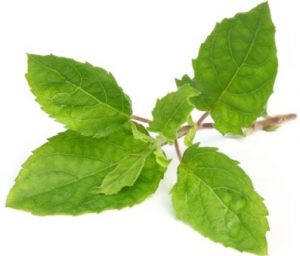
“Orientin (Ot) and Vicenin (Vc), two water-soluble flavonoids isolated from the leaves of Indian holy basil Ocimum sanctum have shown significant protection against radiation lethality and chromosomal aberrations in vivo.” ~ Department of Radiobiology, Kasturba Medical College, Manipal 576 119, India.
Helps Fight Cancer
It was found that holy basil has the potential to prevent cancer. It has the ability to increase antioxidant activity, change gene expression, trig cell death, and slow cell division.
“Preclinical studies have also shown that Tulsi and some of its phytochemicals eugenol, rosmarinic acid, apigenin, myretenal, luteolin, β-sitosterol, and carnosic acid prevented chemical-induced skin, liver, oral, and lung cancers and to mediate these effects by increasing the antioxidant activity, altering the gene expressions, inducing apoptosis, and inhibiting angiogenesis and metastasis.” ~ Father Muller Medical College, Kankanady, Mangalore, Karnataka, India.
Helps Control Diabetes
It was found that basil extracts reduce blood glucose levels and inflammation, which is very good for helping control diabetes development. Also, the basil essential oil helps lower cholesterol levels and this is very good for diabetics as they are at a higher risk for developing high cholesterol. This was found by researchers in the Department of Home Science at Azad University of Agriculture and Technology in India. They did the research on holy basil leaves on humans in double-blind clinical trials showing that basil supplementation can be a good way to help control diabetes.
In another study with 60 Type 2 diabetics, they took 250 mg of holy basil extract and a control group that took a diabetes drug before breakfast and dinner each day for three months. What was found is that the ones taking the holy basil extract had a decrease of 18% in average blood sugar compared to those only taking the drug. – Mahatma Gandhi Medical College & Research Institute.
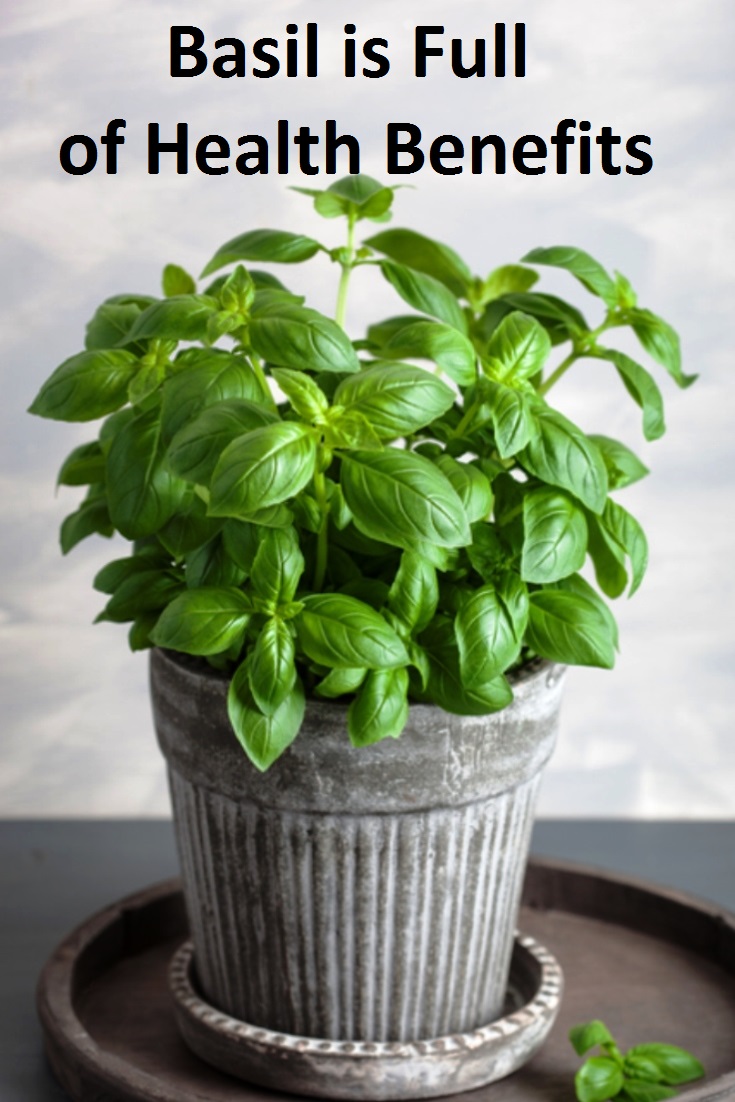
Helps Reduce Stress
A study with 158 people with symptoms of stress, took 1,200 mg of holy basil extract each day for six weeks and they had 39% improvement in stress symptoms compared to the placebo group.
“After six weeks of intervention, scores of symptoms such as forgetfulness, sexual problems of recent origin, frequent feeling of exhaustion, and frequent sleep problems of recent origin decreased significantly…compared with the placebo group.” ~ OP Chaudhry Hospital and Research Centre, India.
Anti-Bacterial Properties
The oils in basil provide protection against unwanted bacterial growth similar to oregano oil (from the same plant family). It inhibits strains of bacteria (Staphylococcus, Enterococcus, and Pseudomonas) which are widespread and have developed resistance to treatment with antibiotic drugs. – Journal of Microbiology Methods, (September 2003). Inhibits Shigella, an infectious bacteria that triggers diarrhea. This makes adding basil to our food and salad dressings a good idea.
Stimulates Appetite and Curbs Flatulence
Basil tea is said to help with dysentery, nausea, and stomach distress due to gas. Research at the Medical University of Lodz in Poland tested basil oil against strains of E. coli which was collected from patients with infections. What they found was that basil was effective in acting against the bacteria and helpful in inhibiting their growth. Now researchers want to study how basil may help fight antibiotic-resistant illnesses and infections.
Promotes Heart Health
This herb is full of high levels of magnesium which helps muscles and blood vessels relax, improving blood flow. Powerful anti-inflammatory from essential oils such as eugenol, citronellol, linalool, citral, limonene, and terpineol are just a few of the oils in basil.
The enzyme-inhibiting effect of the eugenol can help with rheumatoid arthritis or inflammatory bowel conditions.
Alkalizes the Body
Like all ‘greens’ basil provides alkalizing minerals to balance against the typical acidic diet. Basil is so full of phytonutrients that it is also considered a herb in all health systems.
Learn about the health benefits in this video.
Nutrition
Basil is a very rich source of many essential nutrients, minerals, and vitamins. It is a very good source of iron and calcium, and a good source of potassium and vitamin C. It is low in calories and contains no cholesterol.
- This herb contains exceptionally high levels of beta-carotene, vitamin A, cryptoxanthin, lutein andzea-xanthin. These compounds help act as protective scavengers against oxygen-derived free radicals and reactive oxygen species (ROS) that play a role in aging and various disease processes.
- 100 g of fresh herb leaves contain astoundingly 5275 mg or 175% of daily required doses of vitamin A. Vitamin A is known to have antioxidant properties and is essential for vision. It is also required for maintaining healthy mucus membranes and for your skin. Consumption of natural foods rich in vitamin-A has been found to help the body protect from lung and oral cavity cancers.
- Vitamin K in basil is essential for many coagulant factors in the blood and plays a vital role in the bone strengthening function by helping the mineralization process in the bones.
- This herb contains a good amount of minerals like potassium, manganese, copper, and magnesium. Potassium is an important component of cell and body fluids, which helps control heart rate and blood pressure. Manganese is used by the body as a co-factor for the antioxidant enzyme, superoxide dismutase.
- The leaves are an excellent source of iron, contains 3.17 mg/100 g of fresh leaves (about 26% of RDA). Iron, being a component of hemoglobin inside the red blood cells, determines the oxygen-carrying capacity of the blood.
Learn more about Basil Nutrition.
Safety Concern
Basil might be UNSAFE when used in significant quantities long-term. It contains estragole, a chemical that might increase the risk of getting liver cancer. Concentrated basil oil can, therefore, be UNSAFE due to the estragole content. Read more at Medicine Net.
These concerns are based on studies with very high doses applied to mice.
In some people, basil can cause low blood sugar.
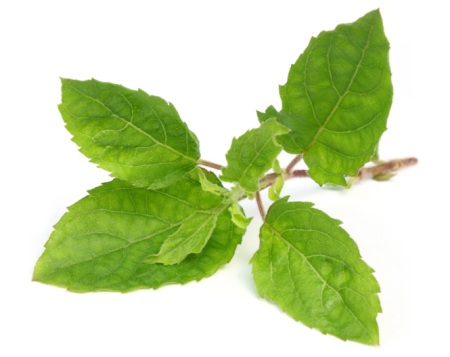
History
- It has been cultivated for more than 5,000 years and is native to tropical Asia and India.
- The name is derived from the Greek basileus which means king.
- Ancient records from 907 A.D. indicate sweet basil in China.
- The plant came westward as whole plants since it could be grown easily indoors away from frost exposure.
- Today, this herb is used as a food flavoring and in perfume, incense, and herbal remedies.
- In ancient times it was used as an antidote for snake bites and gave people strength during religious fasting.
Basil Trivia
- It has always been a token of love in Italy.
- The scent of basil was said to drive men wild, so much so that women would dust their breasts with dried and powdered basil.
- This herb is known across cultures to naturally increase sex drive and fertility by fostering a feeling of total relaxation in the body and muscles while increasing circulation.
- The name is Greek for ‘royal’ or ‘kingly’.
- In ancient Greece and Rome, doctors believed the growers needed to scream wild curses to grow it successfully.
- In old India, this herb was cherished as a symbol of hospitality.
- There were many superstitions in ancient times about Basil. One was they believed that a basil leaf left under a pot would in time turn into a scorpion and smelling the plant could bring a scorpion into the brain.
- When a Romanian boy accepts a sprig of basil from his girl, he is engaged.
- It was used for embalming ancient Egyptian mummies.
- In India, every good Hindu goes to rest with a Basil leaf on his breast. This is a passport to Paradise.
- It was called the herb of poverty and the idea is that it would help protect those in need.
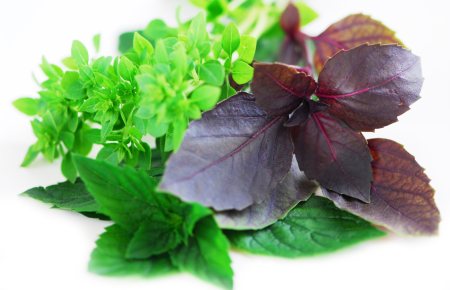 So Many Types of Basil
So Many Types of Basil
Basil adds a distinct tastiness to our food and gives us so many health benefits too. There are 35 types of Basil plants that belong to the mint family. They range from annuals to perennials and shrubs.
Here Are 10 of the Most Common Types of Basil
- Sweet Basil is Italian basil, used in tomato sauce, pesto and salads.
- Greek Basil has been used in cooking and for fragrances for centuries. It has small leaves on dome-shaped, 8″ tall plants. Great with tomatoes, in salads or sauces.
- Cardinal Basil has a rich scent, with a touch of spice. It has deep burgundy stems holding flowers with bright green leaves which is so beautiful in a herb.
- African Blue Basil is minty and peppery with purple flowers and green purple leaves. Good for pesto.
- Genovese Basil has tender, fragrant, extra-large, dark green leaves from Italy. Best for pesto.
- Spicy Saber Basil has a spicy flavor for Asian dishes. It stays bushy and productive late into the season.
- Summerlong Basil is a compact, tight bush, slow to bolt, and covered with shiny, bright green leaves. It is great for ornamental edging in vegetable beds.
- Purple Ruffle Basil is highly aromatic with purple leaves and pink flowers and is beautiful.
- Holy Basil is popular in the east for its medicinal properties. It is also used in Thai cooking.
- Lemon Basil with its fresh lemon fragrance and silver-green plants is native to northwest India. Perfect for salads.

How to Cook, Buy and Store Basil
- For the tastiest basil choose fresh over the dried. Look for fresh vibrant and deep green leaves without darks spots or yellowing.
- Buy organically grown basil; being leafy this means that if pesticides have been used they will be highly absorbed. Also, it has not been irradiated which decreases in its vitamin C and carotenoid content.
- Store fresh basil, wrapped in a slightly damp paper towel in the refrigerator or in a glass of water at room temperature out of direct sunlight. Basil may be frozen, whole or chopped, in airtight containers. Some people freeze the basil in ice cube trays covered with either water to be added when preparing soups or stews.
- Store dried basil in a tightly sealed glass container in a cool, dark and dry place where it will keep up to six months.
- Grow a basil plant in the backyard for fresh leaves whenever you need some.

Tips for Cooking
- Wash fresh basil in cold running water to remove any dust or pesticide residues.
- For the best flavor add at it at the last moment in the cooking process; prolonged cooking results in evaporation of its essential oils.
- Basil and tomatoes love each other! Also, it works well with onions, garlic, and olives.
- When preparing basil for your recipes, it is the leaves that are the best but the small stems are okay. The thick stems are best discarded as they are bitter. Note: Stems contain compounds that will cause your pesto to turn brown and dark.
- The creamy white flowers are edible.
Try These Basil Recipes
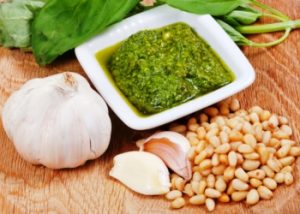
Delicious Vegan Pesto – This is both fresh and raw and delicious. I love this vegan pesto without the cheese; it tastes like the real thing, only better to me! Toss with pasta or serve with bread or crackers for an appetizer.
Basil Tea – Good for nausea and indigestion.
More Tasty Recipes with Basil
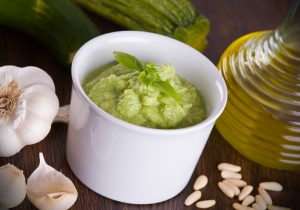
I am a great fan of basil as you will find it in many recipes on my site.
Vegan Zucchini Pesto – This zucchini pesto is lighter than the regular pesto as it has less oil and adds a refreshing zest of zucchini to your pasta. Also, I prefer not to use cheese and the nutritional yeast gives it a delicious flavor.
Easy Peasy Green Pea Soup is Especially Delicious – This green pea soup really is yummy and it is a super easy soup to make. Hearing me say that frozen peas taste good is amazing; as I don’t even like to eat frozen peas. But this creamy green pea soup is really delicious and within a week I had it twice!
Tasty Tempeh Burgers are Vegan and Gluten-Free – These tempeh burgers are tasty and a very good source of protein for dinner. They have all the health benefits with B12. You can make them into burgers with buns or what I do is have them with a salad or steamed vegetables.
Vegan Hemp Heart Pesto is Nut Free and Delicious – This hemp heart pesto is vegan, nut-free and raw. It makes lunch or dinner extra delicious. Most pestos have cheese in them which doesn’t work for those of us who eat dairy-free. I always make my pestos without the cheese. For some, it is best not to eat lots of nuts and this hemp heart pesto is perfect as the hemp hearts add the flavour and texture without the nuts.


I love basil, especially fresh! It is one of my favorite herbs to use in sauces or to sprinkle on sandwiches or salads. Thanks for all of the great information, now I know so much more about this herb.
sure I agree with your article that Basil adds a distinct tastiness to our food and gives us so many health benefits too thanks for the amazing article